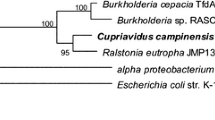Abstract.
Ralstonia eutropha JMP134 (pJP4) harbors two functional gene clusters for the degradation of chlorocatechols, i.e. tfdCDEF (in short: tfd I ) and tfdD II C II E II F II (in short: tfd II ), which are both present on the catabolic plasmid pJP4. In this study, we compared the function of both gene clusters for degradation of chlorocatechols by constructing isolated and hybrid tfd I -tfd II clusters on plasmids in R. eutropha, by activity assays of Tfd enzymes, and by HPLC/MS of individual enzymatic catalytic steps in chlorocatechol conversion. R. eutropha containing the tfd II cluster alone or hybrid tfd-clusters with tfdD II as sole gene for chloromuconate cycloisomerase were impaired in growth on 3-chlorobenzoate, in contrast to R. eutropha harboring the complete tfd I cluster. Enzyme activities for TfdDII and for TfdEII were very low in R. eutropha when induced with 3-chlorobenzoate. By contrast, a relatively high enzyme activity was found for TfdFII. Spectral conversion assays with extracts from R. eutropha strains expressing tfdD II all showed accumulation of a compound with a similar UV spectrum as 2-chloro-cis,cis-muconate from 3-chlorocatechol. HPLC analysis of in vitro assays in which each individual step in 3-chlorocatechol conversion was reproduced by sequentially adding cell extracts of an Escherichia coli expressing one Tfd enzyme only demonstrated that TfdDII was unable to cause conversion of 2-chloro-cis,cis-muconate. No accumulation of intermediates was observed with 4-chlorocatechol. From these results, we conclude that at least TfdDII is a bottleneck in conversion of 3-chlorocatechol and, therefore, in efficient metabolism of 3-chlorobenzoate. This study showed the subtle functional and expression differences between similar enzymes of the tfd-encoded pathway and demonstrated that extreme care has to be taken when inferring functionality from sequence data alone.
Similar content being viewed by others
Author information
Authors and Affiliations
Additional information
Electronic Publication
Rights and permissions
About this article
Cite this article
Laemmli, C.M., Schönenberger, R., Suter, M. et al. TfdDII, one of the two chloromuconate cycloisomerases of Ralstonia eutropha JMP134 (pJP4), cannot efficiently convert 2-chloro-cis,cis-muconate to trans-dienelactone to allow growth on 3-chlorobenzoate. Arch Microbiol 178, 13–25 (2002). https://doi.org/10.1007/s00203-002-0417-3
Received:
Revised:
Accepted:
Issue Date:
DOI: https://doi.org/10.1007/s00203-002-0417-3




